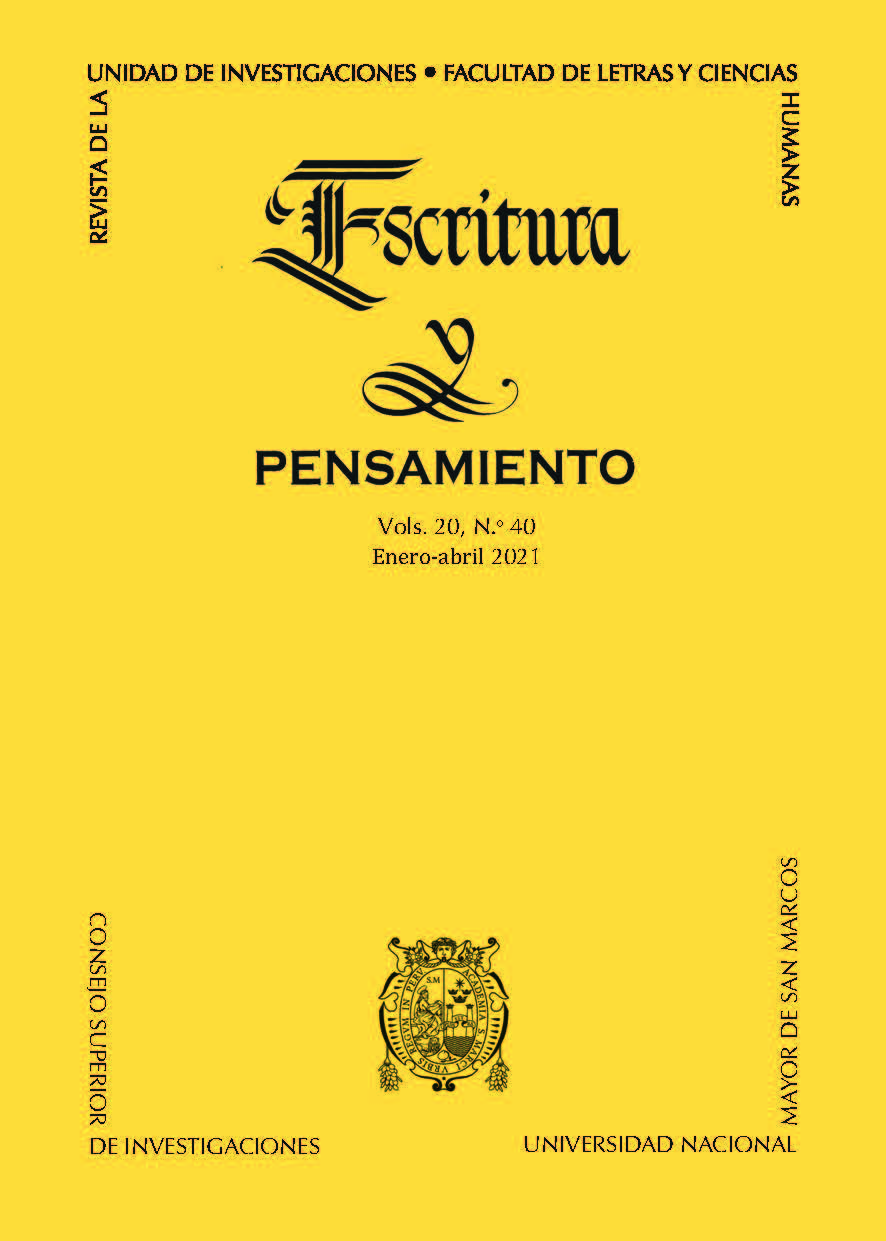Grammatical constructions and representations of the smallpox plague in testimonies of qom elders
DOI:
https://doi.org/10.15381/escrypensam.v20i40.20069Keywords:
smallpox, Qom people, transitive constructions, ergative perspectiveAbstract
The smallpox plague is one of the fundamental themes that are addressed in Stories of the Tobas Aboriginals of the Gran Chaco as told by their elders (2007), by Orlando Sánchez. It is sometimes presented as something spontaneous and inaccessible; others, as a perceptible entity, capable of being controlled. From the perspective of Functional-Systemic Linguistics, the lexicon and grammar of Spanish codify the modes of referring to events in the form of structures that are nucleated around classes of verbs: the processes that are shown as self-generated are generally formulated with inacusative verbs, while those in which the will of the agents are constructed with transitive verbs. In the testimonies that the book unfolds, the transitive and the ergative perspective are combined, and both give an account of the ways of conceiving the disease and the effects it produces in the Qom community.
References
Campos, H. (1999). Transitividad e intransitividad. En I. Bosque & V. Demonte. Gramática descriptiva de la lengua española. Madrid: Espasa Calpe.
Ceriani Cernadas, C. (2013). Fronteras, espacios y peligros en una misión evangélica indígena en el Chaco Argentino. (1935-1962). Boletín Americanista. 67, 143-162. http://dialnet.unirioja.es/descarga/articulo/5065990.pdf
Cicerchia, R., Rustoyburu, C., & Garabedian, M. (2015). Discursos sanitarios y rieles. Noroeste argentino entre las décadas de 1920 y 1940. Población & Sociedad, 22 (1), 31-59. http://ppct.caicyt.gov.ar/index.php/pys/article/view/3540
Di Liscia, M. S. (2011). Marcados en la piel: vacunación y viruela en Argentina (1870-1910), Ciênc. saúde coletiva, 16 (2), 409-422. https://www.redalyc.org/articulo.oa?id=63018970005
Favaro O. & Iuorno G. (2009). Un país a dos velocidades. Provincias y Territorios Nacionales. Argentina, 1884-1991. En B. Rajland & M. C. Cotarelo (compiladoras). La Revolución en el Bicentenario. Reflexiones sobre emancipación, clases y grupos subalternos. Buenos Aires, Clacso. http://historiapolitica.com/datos/biblioteca/favaroiuorno.pdf
Fernández Soriano, O. & Táboas Baylín, S. (1999). Construcciones impersonales no reflejas. En I. Bosque & V. Demonte. Gramática descriptiva de la lengua española. Madrid: Espasa Calpe.
Fleitas, M. (2006). Cuerpos elocuentes: Epidemias y endemias en Jujuy durante la década de 1930. KAIROS. 10 (18), https://dialnet.unirioja.es/descarga/articulo/7225159.pdf
Ghio, E. & Fernández M. D. (2008) Lingüística Sistémico Funcional. Aplicaciones a la lengua española. Santa Fe: Universidad Nacional del Litoral, Waldhuter Editores.
Halliday, M.A.K. (Revised by C. Matthiessen). (2014). Halliday’s Introduction to Functional Grammar. London: Routdledge.
Lerch, E. & Sociedad Bíblica Argentina (2020). Orlando Sánchez 1941-2020. https://sba.org.ar/orlando-sanchez-1941-2020/
Mendikoetxea, A. (1999a). Construcciones con se: medias, pasivas e impersonales. En I. Bosque & V. Demonte. Gramática descriptiva de la lengua española. Madrid: Espasa Calpe.
Mendikoetxea, A. (1999b). Construcciones inacusativas y pasivas. En I. Bosque & V. Demonte. Gramática descriptiva de la lengua española. Madrid: Espasa Calpe.
Parolo, M. P., Campi D. & Fernández M. E. (2010). Auge azucarero, mortalidad y políticas de salud en San Miguel de Tucumán en la segunda mitad del siglo XIX. Estudios Sociales, 20 (38), 39-72. https://dialnet.unirioja.es/descarga/articulo/7624271.pdf
Real Academia Española (2016). Nueva gramática de la lengua española. Morfología. Sintaxis. Fonética y fonología. Barcelona: Espasa. En libro electrónico (epub).
Sánchez, O. (2007). Historias de los aborígenes tobas del Gran Chaco contadas por sus ancianos. Sáenz Peña, Chaco: Acción Apostólica Común, Instituto Universitario ISEDET, Sociedad Bíblica Argentina.
Downloads
Published
Issue
Section
License
Copyright (c) 2021 Estela Josefina Picón

This work is licensed under a Creative Commons Attribution 4.0 International License.
AUTHORS RETAIN THEIR RIGHTS:
a. The authors retain their trademark and patent rights, and also over any process or procedure described in the article.
b. The authors retain the right to share, copy, distribute, execute and publicly communicate the article published in the Escritura y Pensamiento (for example, place it in an institutional repository or publish as part a book), with acknowledgment of its initial publication by Escritura y Pensamiento.
c. Authors retain the right to make a subsequent publication of their work, to use the article or any part of it (for example: a compilation of their work, lecture notes, thesis, or for a book), provided that they indicate the source of publication (authors of the work, journal, volume, number and date).













